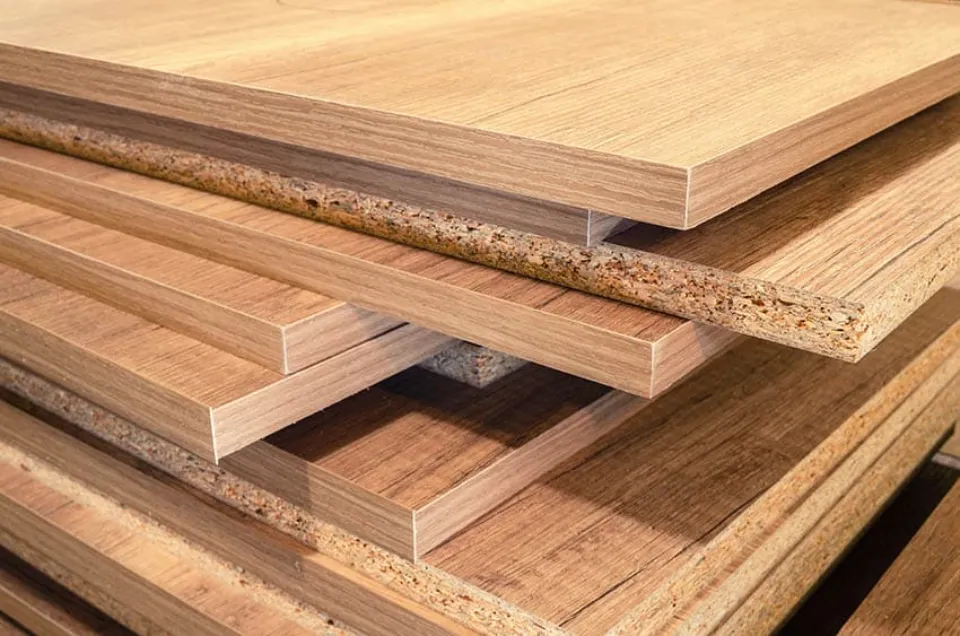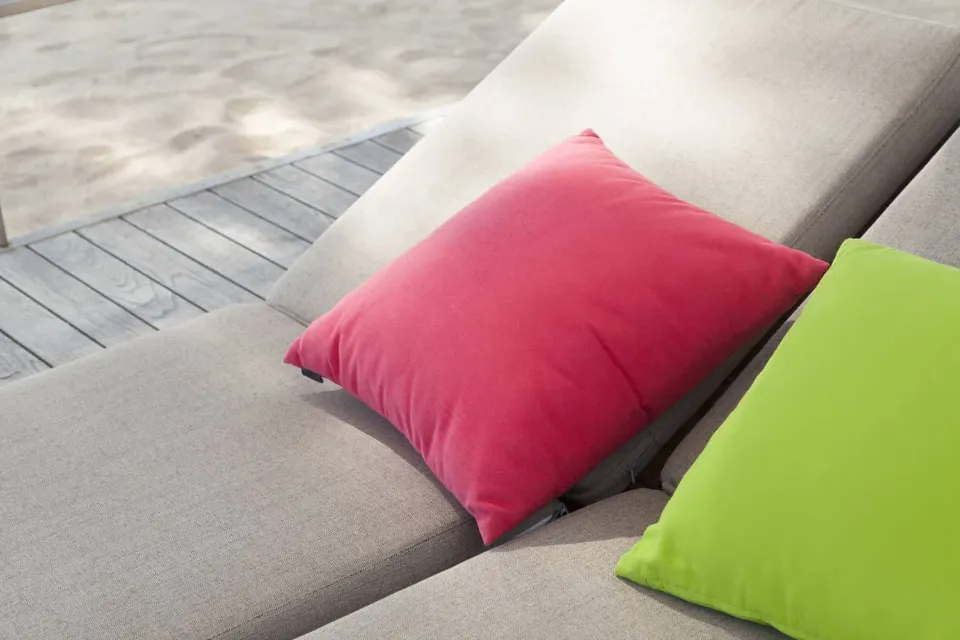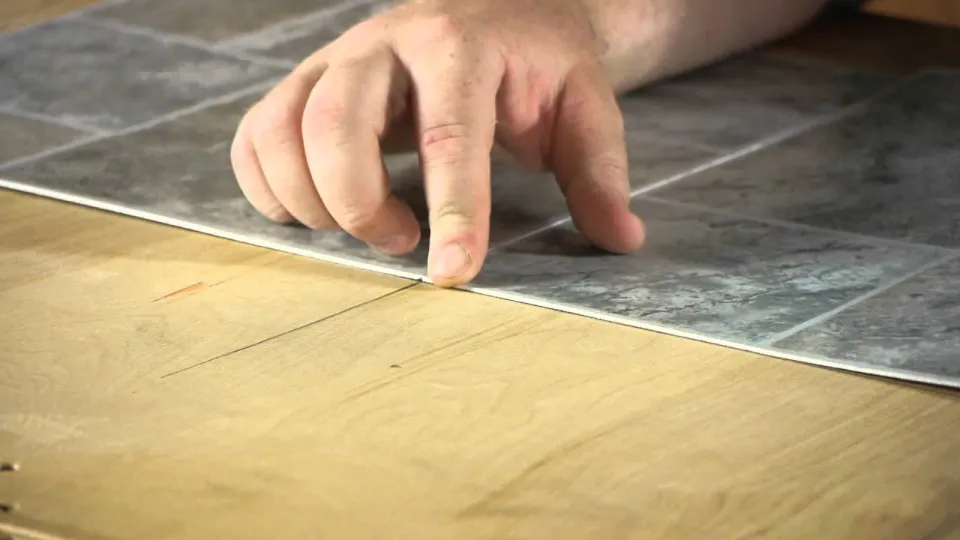I’ll delve deeper into hot topics that come up frequently when discussing manufactured wood, such as its applications, good and bad qualities, differences from solid wood, how it compares to engineered wood, and many others.
The term “manufactured wood” refers to wood that has been altered and improved through the joining and pressing of various wood pieces with other materials like glue and sawdust. Real wood is used in manufacturing as the top layer, and it is protected with melamine. Below that is a layer of wood composite commonly known as Medium Density Fiberboard (MDF).
Please read on for more detailed information.
What is Manufactured Wood?
Consequently, what is manufactured wood? Similar to engineered or manufactured wood flooring, manufactured wood desks feature a real wood veneer on top. To shield the wood surface and stop it from being scratched, stained, or burned, this top layer of wood veneer is typically covered with a thin layer of melamine. Under this top layer of wood veneer is pressed board, sometimes called MDF (medium density fiberboard). In order to create this material, different pieces of wood were combined and pressed together to create wood composite. One of the main components of most homes, plywood is one of the main building materials that it resembles in appearance and quality.
It is significantly less expensive and lighter to use this wood composite, which are its two main benefits. This means it makes furniture more affordable and easier to ship (as well as easier to move around for the users of the furniture). However, don’t make the mistake of thinking that manufactured wood is light or flimsy. The wood composite underneath the wood veneer on manufactured wood desks is neither inexpensive nor light. It is less densely made of wood than solid wood, but it is still quite heavy. A typical 60″ desk will weigh 100 pounds or more. The made-of-wood desks that we sell on the website are incredibly sturdy and quite heavy. (In fact, we remove any desks that receive unfavorable reviews right away so that we can only offer products from the best manufacturers. So although these manufactured wood desks are not “solid wood,” they are very high quality (and much more affordable).

Is Manufactured Wood Good?
The benefits of manufactured wood are numerous, but you should also be aware of some drawbacks.
Pros of Manufactured Wood
- Smooth and flat surface:The surface of manufactured wood is flat and smooth when it is created. Knots, cracks, and extra lines are not present in the commercially available wood, which has these flaws.
- Cheaper: Some manufactured wood products cost a lot less than their equivalents in the natural world. A sizable sum of money can be saved by using manufactured wood.
- Versatile:Natural wood is much less adaptable than manufactured wood, which makes it less suitable for many projects and easier to cut.
- Durability: Manufactured wood created under the right circumstances is sturdy and will last a long time.
- Flexibility:Natural wood is not as flexible as manufactured wood due to its special composition.
- Environmentally friendly: It is not necessary to cut down a tree to produce manufactured wood. It is more environmentally friendly than alternatives made of natural wood because it is made from scraps.
Cons of Manufactured Wood
- Minimal resistance to moisture and humidity:Wood that has been manufactured is not intended to withstand moisture and humidity. The likelihood of the material absorbing water is very high.
- Heavy and sturdy: Wood that has been manufactured can be robust and heavy. While that’s not a bad thing, it makes it difficult to manage if you’re working alone on a project.
- Veneers showing at the edges:Rough edges could be left by the way manufactured wood is built. Compared to natural wood, these require more effort to remove.
- Formaldehyde: Formaldehyde is frequently used to manufacture manufactured wood. Man-made wood can emit carcinogens into the air when it is cut, releasing dust. If the proper safety measures are not taken during the cutting process, it can harm the user.

Types of Manufactured Wood
Right now, there are a huge variety of manufactured wood products on the market. The most popular types of manufactured wood are,
- Particleboard or Chipboard
- Fiberboard
- Medium Density Fiberboard (MDF)
- Plywood or Laminated board
- Veneer wood
So let’s talk about each of those manufactured wood types, their uses, and advantages and disadvantages.
Particleboard Or Chipboard
By joining adhesives with sawdust and resin, particleboard is a cheap, low-density flat board.
It is well-known for its affordable manufacturing. Veneer is typically added by woodworkers to enhance the strength, appearance, and stain resistance of the wood.
Uses of Particleboards are,
- Low-end furniture
- Underlayment
- Flooring
- Wall paneling
- False ceiling
- Core material for doors
As you can see, particleboard is a versatile, inexpensive form of wood that has many advantages.

Fiberboard
In comparison to other types of manufactured wood, fiberboard is a dense board. It is much less likely to break or chip.
Wood is chopped into tiny pieces and heated until it becomes fibers, which is how fiberboards are made. After that those fibers dry and bond together with adhesives to form fiberboards.
Uses of Fiberboard are,
- Roofing material
- Furniture making
- Doors, cabinets, and other home interiors
- Insulation
- Soundproofing

Medium Density Fiberboard (MDF)
Due to their excellent qualities, medium-density fiberboards are the most widely used manufactured wood. MDF is dense and the strength is also high. cheaper than solid woods on a relative basis.
Adhesives and sawdust are used to create medium density fiberboard. They will first dehydrate and heat. After that, they’ll bond together using resins to get the output.
Then they will use enormous machines to cut precisely to predetermined dimensions.
There are numerous applications for MDF when we consider them.
Uses of medium density fiberboards (MDF) are,
- Furniture making
- Soundproofing
- Roofing
- Cabinetry
- Doors and frames
- Flooring
Because of this, medium density fiberboards (MDF) are regarded as the best substitute for real wood.
For the most part, even during production and maintenance, the MDF projects I worked on over the years went well.
You can keep them for many years without any problems if you maintain them properly.

Plywood Or Laminated Board
As the strongest manufactured wood, plywood is well-known. Plywood is manufactured by layering multiple layers of veneers until they create a sturdy and smooth solid board. Veneer crosswiring along the grain will normalize the properties of shrinking and swelling.
The quantity of veneers used determines the quality and characteristics of plywood.
Uses of Plywood are,
- Wall sheathing
- Roofing
- Flooring
- Interior walls
- Furniture making
- Cabinetry

Veneer Wood
A thin piece of wood called the veneer is pressed onto the core panels. It is made from shaved natural wood that is attached to chipboard, MDF, or plywood.
It is thinner than 1/8 inches. Veneer comes in a variety of qualities and has numerous applications. It is also a component of other woods used in manufacturing.
Uses of Veneer,
- Flooring
- Walls
- Ceiling
- Furniture making
- Artworks

Which Wood is Used to Make Manufactured Wood?
All types of wood, whether hardwood or softwood, can be combined and bound to create manufactured wood.
To achieve different objectives, a few manufacturers, however, favor using particular types of wood to create manufactured wood.
For instance, boards made of hardwood alone are more robust and long-lasting than those made of softwood alone or softwood plus hardwood. Engineered woods made exclusively of softwoods, on the other hand, are more reasonably priced.
Anyway, common manufactured boards combine the two types of wood. Hardwood is used for the outer layer while softwood is used for the inner layer.
Maple, oak, walnut, and teak are common hardwoods used to create manufactured woods. Meanwhile, cedar, fir, and pine are the most widely used softwoods for the production of engineered wood.
Is Manufactured Wood Durable?
In some circumstances, manufactured wood can be just as durable as natural wood. However, it depends on the manufacturing process and the materials used.
For instance, particle board furniture that is inexpensive is not nearly as durable as solid wood furniture.
Although solid wood is more durable, using manufactured deck flooring can actually be much more so.
Ultimately, it depends on the type and quality of the manufactured wood you choose.

What is Manufactured Wood Use For?
The various uses for manufactured wood have already been demonstrated. But to summarize, you can use manufactured wood for the following;
- Wood flooring
- Decking
- Furniture making
- Cabinet making
- Roofing
- Decking
- Making ceilings
- Artworks
- Constructing interior walls
- Making doors and frames
Engineered Wood Vs Solid Wood
Real/solid wood and manufactured wood are frequently confused by many people. Therefore, before combining the two, it’s crucial to understand their differences.
The main differences between manufactured wood and solid woods are highlighted in the production process, wood stability, thickness, and sanding. Here’s what you need to know;
- Production
Solid wood is made by felling fully grown trees (hardwoods or softwoods) and chopping the heartwood (and heartwood, in some cases) into various sizes.
The production of manufactured wood, on the other hand, entails using adhesives to bind several layers of pre-existing solid woods and wood products, such as sawdust and veneers.
- Weight
Solid wood is much heavier than manufactured wood. In contrast to common hardwoods, light softwoods like pine weigh only 2.5 lbs/board foot.
For instance, cherrywood weighs 3.0 lbs per board foot and walnut weighs 3.3 lbs per board foot. Although some manufactured boards are heavier than some types of solid lumber, manufactured wood generally weighs less.
- Hardness
Solid wood typically has a higher hardness rating than engineered wood. The type of solid wood and manufactured wood matters, though.
For instance, MDF is frequently compared to red oak, which has a Janka rating of 1,200, while hickory has a Janka rating of 1,800.
MDF, on the other hand, has a Janka rating of 1200, making it harder than black walnut (1010 Janka), cedar (900 Janka), and even. This is impressive given that walnut is hardwood.
- Thickness
Solid wood is typically 2 ¼ inches thick and comes in planks that range in width from 5 to 11 inches. As for manufactured wood, it typically ranges in thickness from 38 inches to ½ of an inch. Typically, the width of the planks ranges from 1 ¼ to 5.0 inches.
- Uses
Every type of woodworking project, including the creation of furniture, cabinets, and household items for indoor and outdoor use, uses solid wood. Additionally, they are utilized in building, flooring, and construction projects.
Manufactured boards, on the other hand, are used in smaller applications, particularly roofing, flooring, furniture construction, and decking.
- Sanding
You can sand solid wood several times for many years without adverse effects. But repeatedly sanding manufactured wood will have a negative impact.
In fact, the industry norm is to only sand manufactured wood twice or three times throughout its lifespan. Otherwise, the delicate layers would be harmed.
- Cost and availability
Manufactured wood is cheaper than solid wood and more readily available. Plywood and MDF are ubiquitous in your neighborhood lumberyard, and they cost anywhere from $2.50 to $10 per square foot.
At the same time, it can be difficult to locate the precise solid wood you need for a project, and the cost can be higher—between $4 and 412 per square foot.
- Others
Additionally, solid wood is more environmentally friendly and dimensionally stable than engineered wood. But manufactured wood is more workable and simpler to install.

Grades of Manufactured Wood
One of the most important things you need to consider when purchasing manufactured wood is its grades.
In contrast to solid wood, if you accidentally purchased low-grade manufactured wood for a high-end woodworking application, there is no way to recover it short of completely rebuilding the item.
The main difference between grades of manufactured wood is the number of voids and knotholes in the wood.
The amount of repairing need to cover defects determines the grades of manufactured wood. Grading also takes into account the adhesive’s quality.
APA Engineered Wood Association method is the best available method to determine the grades of manufactured wood. So, here is the grading method,
| Grade | Properties |
| A | Highest quality Expensive Veneers are flawless Smooth Can easily be painted |
| B | High-quality Small patches Less smooth than grade A Minor flaws can easily repair |
| C | Knots are visible with a 1.5-inch diameter Discoloration happens easily Smooth patches |
| D | The quality can destroy within seconds due to defects Cheapest manufactured wood type Repairing is hard |
As you can see, the grades of manufactured wood as well as their quality vary significantly.
Depending on the type of application you plan to use, you must choose a grade.
For instance, if you’re planning to build cabinets, always choose A grade manufactured wood over other grades because it will hold screws and nails more easily and will be simpler to paint and stain.
The final woodworking application is sturdy, light, and long-lasting because it has numerous thin wood layers arranged in crosswire directions.
Plywood excels at creating cabinets because it has all those characteristics.
If you’re on a tight budget, use MDF (medium density fiberboards). MDF is the most adaptable manufactured wood and can be used for the majority of woodworking projects.
Whatever manufacturing wood you use, always make sure to,
- Keep it clean
- High quality
- Keep away from moisture
- Clean cutting
- Give proper maintenance
Are There Toxins in Manufactured Wood?
Although the majority of manufactured wood types don’t release toxins, they are still made with toxic materials.
When cutting wood in a small space, for example, these can be dangerous.
Formed with formaldehyde, chemically engineered wood. However, when cut or used, this chemical may release. It shouldn’t leech from the product.
Is Manufactured Wood Safe?
Manufactured wood has been around for quite some time. It was first introduced in the 1930s as a means of producing robust, long-lasting goods without using as many natural resources.
Over the years, it’s become an extremely popular product for a wide range of applications but some have risen concerns over the materials used inside of it, namely formaldehyde.
While there are some dangers associated with manufactured wood, it is still considered a safe product.
You should be safe as long as you aren’t cutting it in a confined, small space.

FAQs
Is Manufactured Wood Real Wood?
Manufactured wood, also called MDF (Medium Density Fiberboard) or engineered wood, is a wood-like composite made by heating, compressing, and binding sawdust, real wood chips, and fiber together. While some furniture manufacturers use solid wood, others use it.
Is Manufactured Wood Good for Furniture?
This produces a composite material that resembles wood and is less expensive and lighter than real wood. Manufactured woods have become increasingly popular over the past few years due to their affordability and realistic appearance. They are now used for a variety of purposes, including furniture.
What is the Difference Between Natural Wood and Manufactured Wood?
Man-made boards are reconstructed sheet materials made from wood products like chippings and fibers, whereas natural timber is essentially the wood that has been cut from the tree into planks of various sizes and cross-sections.
Does IKEA Use Manufactured Wood?
IKEA’s furniture, on the other hand, is primarily recognized for being made of compressed wood chips sandwiched between plastic veneer. That said, IKEA has a large offer of solid wood such as pine, oak, birch, beech, or acacia. IKEA can therefore be made of real wood.
Summary: What is Manufactured Wood?
What is Manufactured Wood? Engineered wood, also referred to as manufactured wood, is a type of wood that has undergone improvements and modifications. It is created by combining various types of wood with materials like glue and sawdust. Medium Density Fiberboard (MDF) serves as the base, and a top layer of real wood is protected by melamine.
If you have any questions, please leave a comment. My Prime Home tries to give you the best home improvement information. Don’t forget to share the post. Thank you for reading.



